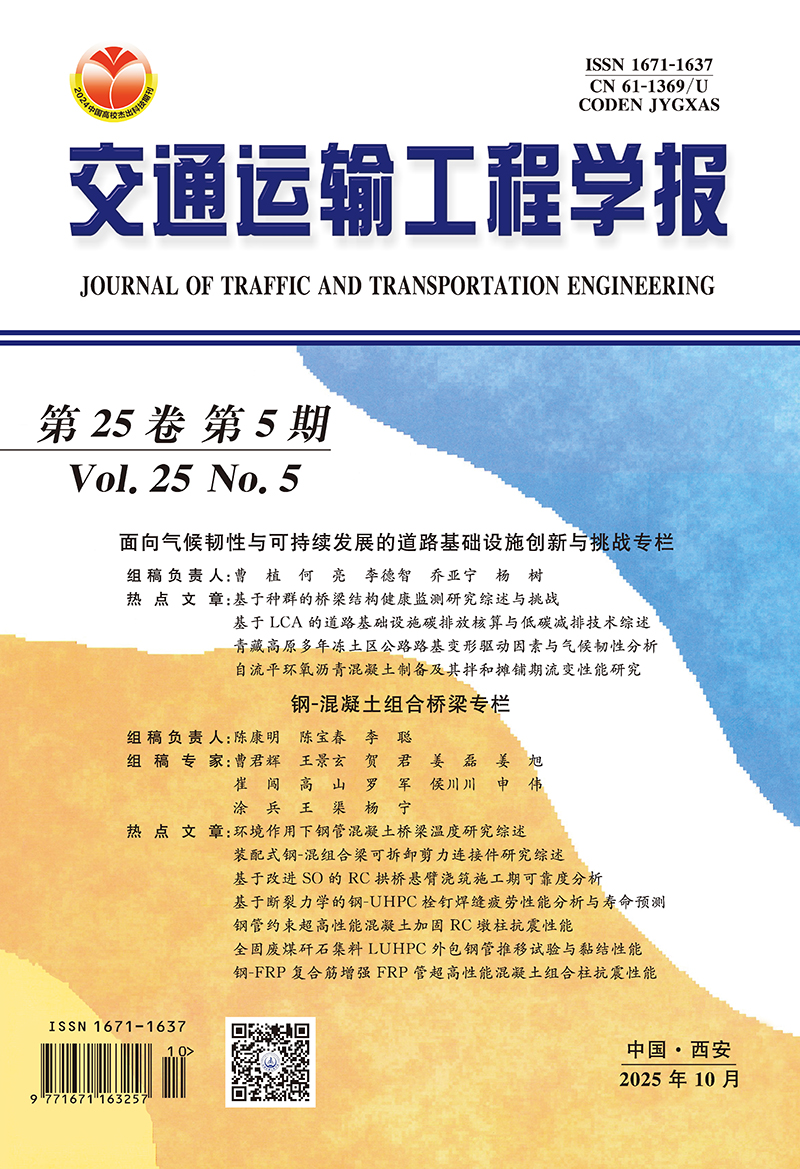User Center
Journal Info
(Founded in 2001 bimonthly )
ISSN 1671-1637 CN 61-1369/U CODEN JYGXAS


Collection of Source JournalsMore>
- Ei Compendex
- AJ
- INSPEC
- JST
- CSA: Technology
- Scopus
- IC
- CSCD
- GCJC
- CAJCED
- CSTPCD
To meet the precast assembly and service performance demands of bridge deck asphalt pavements (BDAP), the balance design method and development procedures of self-leveling epoxy asphalt concrete (SLEA) were proposed based on guss asphalt concrete and epoxy asphalt concrete. The effects of different gradations and asphalt-aggregate ratios on the flowability and mechanical strength of SLEA were investigated. The rheological properties of SLEA during the mixing and paving periods were analyzed. Based on Bingham's plastic fluid mechanics properties, the generalized mixing viscosity of SLEA was defined. Considering aggregate morphological features including needle flake index, fractal dimension, as well as gradation composition characteristics including shape parameters and scale parameters, a prediction model for the rheological properties of SLEA during mixing and paving periods was built. Research results show that the flowability (at 200 ℃) of fine, medium, and coarse-graded SLEA10 is 15, 25, and 32 s, respectively, while the penetration (at 60 ℃) reaches 245, 233, and 228 (0.01 mm). All values exceed the specification requirements, demonstrating excellent flowability and mechanical strength to meet precast assembly and service performance demands. Gradation significantly influences SLEA10 flowability but has relatively small influences on its strength. The flowability mainly depends on the gradation fineness and aggregate characteristics, while the strength after molding mainly depends on the consolidation of epoxy asphalt, with gradation fineness playing a minor role. The established prediction model of generalized mixing viscosity achieves an determination coefficient of 0.94 between measured values and fitted values, demonstrating its effectiveness in predicting rheological properties. Based on the analysis results, it is recommended to choose the aggregates with regular size, low surface roughness, and finer gradation to realize the self-leveling and compaction-free function.
More>中国高速铁路是世界高速铁路发展中重要的一部分,从历史观点(人类社会发展的必然)和全球视野(世界高速铁路发展的延续)两方面重点回顾了中国高速铁路的崛起和发展历程,从宏观角度分析了世界高速铁路发展的时间轴,阐述了4次世界工业革命不断催生交通运输技术的重大进步,指出了世界高速铁路的发展都要经历4个阶段:酝酿、探索、成熟、发展。美国最早提出建设高速铁路,但至今还在酝酿期。日本、法国、德国等仍然处于探索期。只有中国高速铁路已进入快速发展期。围绕中国高速铁路取得的巨大历史成就,阐述了中国高速铁路引进、消化、吸收再创新到自主创新的过程,阐明了中国高速铁路之所以取得世界瞩目的重大成就,从政策层面看,主要是因为中国在吸收各国探索经验的基础上,在政府统筹下集中力量办大事,充分整合和利用企业、高校、科研院所等的资源优势,创建了轨道交通国家技术创新体系;从技术层面看,主要原因是取得了技术突破、理论突破和试验突破三大重要突破。探讨了高速铁路发展面临的技术挑战,论述了高速铁路关键技术的研究进展,展望了后高铁时代轮轨高铁和磁悬浮高铁的发展方向,提出了智能高铁、智慧高铁、数字高铁等未来发展思路,以期为中国高速铁路的未来走向和发展提供参考,助力中国交通强国伟大梦想的实现。
为了解近20年世界拱桥的发展情况, 分析了钢拱桥、混凝土拱桥和钢管混凝土拱桥等拱桥的建设和技术创新, 展望了拱桥今后的发展趋势。分析结果表明: 在活载比重较大、动力问题比较突出的高速铁路桥梁中, 拱桥刚度大, 应用优势突出。在跨径方面, 3种大跨径拱桥的平均跨径分别为464、370和425 m, 且最大跨径不断增大, 以钢管混凝土拱桥最为明显。在材料方面, 高强钢在钢拱桥中的应用趋势并不明显; 混凝土拱桥的材料强度随着跨径的增大而不断提高, 超高性能混凝土已经得到应用; 钢管混凝土拱桥的拱肋材料强度在不断提高; 超高性能砂浆的提出将有助于提高圬工拱桥的竞争优势。在结构方面, 主拱采用新材料和钢腹板(杆)-混凝土组合截面, 与其他结构形成组合结构, 以及桥面连续化、轻型化和强调强健性, 是重要的技术进步。在施工技术方面, 钢管混凝土劲性骨架施工法、转体施工法和快速施工法等的发明, 推动着拱桥施工技术的进步。在结构创新与技术进步的推动下, 由于拱桥在美观、经济、结构等方面的独特优势, 今后仍将被大量修建; 超高性能混凝土有望为拱桥发展带来革命性的变化; 在跨径方面, 近期可望取得明显突破的是混凝土拱桥; 桥面系与主拱共同受力、连续化、轻型化和强调强健性也是重要发展方向。
从磁悬浮轨道交通的基本原理、磁悬浮列车的技术特点等角度出发,简述了世界各国高速磁悬浮轨道交通的发展概况,对比了常导电磁悬浮、永磁电动磁悬浮、低温超导电动磁悬浮和高温超导磁悬浮等4种磁悬浮方式的研究历史、悬浮特点、悬浮间隙、悬浮能耗、控制系统、技术成熟度与应用情况;采用文献调研、比对、分析、提炼等方法,综述了国内外高校、研究机构和企业对于高速磁悬浮的研究进展;比较了各类磁悬浮轨道交通的原理、技术优势和劣势,分析了高速磁悬浮轨道交通在应用方面的可行性与不足,探讨了4种磁悬浮方式的技术经济性和应用前景与场景;提出了当前发展高速及超高速真空管道磁悬浮轨道交通亟待解决的牵引制动控制、动力和热力学、安全救援、管道密封性能与抽真空效率、无线通信、车内环境控制等6个关键科学问题,并介绍了中国原创高温超导磁悬浮的基础研究及关键技术研发进展与研发计划。研究结果表明:在400~600 km·h-1速度范围可采用常导电磁悬浮或超导磁悬浮技术;在600~1 000 km·h-1速度范围可采用超导磁悬浮技术;1 000 km·h-1及以上的速度可采用高温超导磁悬浮与真空管道或电动磁悬浮与真空管道的磁悬浮技术;作为一种前瞻性研究,高温超导与真空管道磁悬浮关键技术的突破和验证对推动中国乃至世界轨道交通快速发展具有重大而深远的意义。
总结了路面检测重要研究成果, 分析了路面损坏、平整度、车辙、抗滑性能(构造深度) 和结构强度(弯沉) 检测技术的发展现状, 研究了路面检测技术的不足与发展方向。研究结果表明: 国内外路面检测技术的发展经历了3个阶段, 从早期传统的人工检测到20世纪末的半自动化检测, 发展到目前的无损自动检测; 无损自动检测的主要特点是快速与智能化, 采用多源传感器协同工作, 并且集成在多功能道路检测车上, 能够同时检测路面损坏、平整度、车辙、抗滑性能和结构强度以及道路线形与沿线设施等; 在路面损坏检测方面, 采用数字图像检测技术, 实现了路面裂缝的快速检测; 在路面平整度检测方面, 采用激光位移传感技术, 实现了快速自动化检测; 在路面车辙检测方面, 采用激光和数字图像技术, 实现了非接触智能化检测; 在路面抗滑性能和结构强度检测方面, 建立了铺砂法与贝克曼梁法检测结果的相关关系, 实现了基于激光技术的路面构造深度与弯沉快速检测; 为了减少外界因素对现有检测技术和检测设备的干扰, 提高检测信号的信噪比, 应该开发适合各种工况下的路面检测和数据处理方法, 实现路面检测高效化与智能化。
从特征传输方式、空间维度、特征维度3个角度,论述了近年来卷积神经网络结构的改进方向,介绍了卷积层、池化层、激活函数、优化算法的工作原理,从基于值、等级、概率和转换域四大类总结了近年来池化方法的发展,给出了部分具有代表性的激活函数对比、梯度下降算法及其改进型和自适应优化算法的工作原理和特点;梳理了卷积神经网络在车牌识别、车型识别、交通标志识别、短时交通流预测等智能交通领域中的应用和国内外研究现状,并将卷积神经网络算法与支持向量机、差分整合移动平均回归模型、卡尔曼滤波、误差反向传播神经网络、长短时记忆网络算法从优势、劣势和在智能交通领域的主要应用场景三方面进行了对比;分析了卷积神经网络在智能交通领域面临的鲁棒性不佳和实时性较差等问题,并从算法优化、并行计算层面和有监督学习到无监督学习方向研判了卷积神经网络的发展趋势。研究结果表明:卷积神经网络在视觉领域具有较强优势,在智能交通系统中主要应用于交通标志、车牌、车型识别、交通事件检测、交通状态预测;相比其他算法,卷积神经网络所提取的特征更加全面,有效地提高了识别准确度与速度,具有较大的应用价值;卷积神经网络未来将通过网络结构的优化、算法的改进、算力的提升以及基准数据集的增强,为智能交通带来新的突破。
分析了超高性能混凝土(UHPC)的收缩特性及其随时间发展的一般规律, 总结了材料组成、养护制度与内部温湿度场对UHPC收缩的影响。研究结果表明: UHPC收缩早期(0~7 d)发展快, 占总收缩的61.3%~86.5%, 中期(7~28 d)发展缓慢, 占总收缩的13.5%~27.9%, 后期(28 d后)趋于稳定; UHPC以自收缩为主, 占总收缩的78.6%~90.0%, 是早期开裂的主要诱因; 收缩测试起始时间可取试件成型后1 d(24 h), 终止时间可取90 d或120 d; 在结构设计时, 可参考各国规范取收缩为500~800 με, 热养护后可不考虑残余收缩; 对于收缩预测模型, 各国规范尚未统一, 多借鉴现有的收缩模型, 应完善与修正收缩预测模型; 对于材料组成, 目前集中于纤维、矿物掺合料的种类和掺量对收缩的定量影响, 且各组分对收缩的影响不同, 评价指标较为单一, 应结合结构用途、制备工艺与施工过程等进行综合评价; 对于内部温度与湿度场, 研究对象主要集中于28 d后的普通混凝土与高强高性能混凝土, 应深入研究胶凝材料含量大、组分差异性明显、活性矿物掺合料掺量高的UHPC早期内部温度与湿度场; 为了降低收缩, 基本采用内养护, 添加膨胀剂、减缩剂与粗骨料等措施。可见: 为了减小UHPC收缩的同时又不降低其力学性能, 应该优化UHPC配比, 合理使用外加剂, 采取适当养护制度等措施。
分析了自动驾驶汽车自适应巡航控制(Adaptive Cruise Control, ACC) 和协同自适应巡航控制(Cooperative Adaptive Cruise Control, CACC) 车辆跟驰模型, 从系统控制原理、车车通信技术与车间时距方面阐述了ACC与CACC车辆的异同点; 将目前主流ACC/CACC车辆跟驰模型分为3类: 基于智能驾驶的车辆跟驰模型、加州伯克利大学PATH实验室车辆跟驰模型与基于控制论的车辆跟驰模型, 总结3类车辆跟驰模型的建模思路与主要优缺点; 从道路通行能力、交通安全和交通流稳定性3方面, 分析了ACC/CACC车辆对交通流特性的影响, 及其研究现状与未来发展趋势。研究结果表明: 不同的ACC/CACC车辆跟驰模型对通行能力的影响存在较大差别, ACC/CACC车辆有利于提升交通安全性, 但由于缺乏统一的安全性评价指标, 难以量化ACC/CACC车辆对交通安全性的影响程度; 小规模实车试验验证了ACC车辆具有不稳定的交通流特性, 否定了ACC车辆稳定性数值仿真结果, 而数值仿真试验和小规模实车试验均表明CACC车辆可较好提升交通流稳定性, 因此, 完全依赖于计算机仿真试验无法获得令人信服的结论, 实车试验是ACC/CACC研究的必要途径; 为了完善ACC/CACC在交通领域的研究, 应构建不同ACC/CACC车辆比例下的混合交通流基本图模型、智能网联环境下的ACC/CACC车辆跟驰模型建模方法与ACC/CACC混合交通流稳定性解析方法。
基于电磁悬浮型中低速磁浮列车的工作原理,阐述了中低速磁浮各核心子系统(悬浮导向系统、牵引电机、走行机构、制动系统、轨道-桥梁结构等)的技术特征,综合分析了各子系统存在的技术问题和解决方案;梳理了日本Linimo列车、韩国EcoBee列车、长沙磁浮快线、北京磁浮S1线和西南交通大学自主研发的(悬挂)中置式磁浮列车的发展历程及技术特点,总结了中低速磁浮列车的技术重点和难点。研究结果表明:车-轨耦合振动应综合考虑悬浮控制、车辆结构参数、桥梁结构参数、空气动力效应、直线电机等因素的影响,建立完备的车-轨耦合振动研究模型;悬浮冗余匮乏可综合利用机械冗余和电气冗余的技术特点,对中低速磁浮的冗余设计方案进行改进;磁浮靴轨受流应与地铁靴轨受流区分,充分考虑磁浮列车的耦合作用特性,探索无缝供电轨技术在中低速磁浮中的工程实用性;悬浮控制由于控制器主频较低,程序运行周期过长,应提高控制算法和悬浮系统故障诊断技术的精确性和稳定性;车辆轻量化设计应在保证结构强度的基础上,综合考虑车体、走行机构等多因素的结构特点,以提高中低速磁浮列车运载能力;应综合不同磁浮线路要求,建立统一的线路标准,提高中低速磁浮工程化应用能力。
为了在发生重大突发公共卫生事件时提高城市医疗物资的应急救援效率, 减少人员伤亡与经济损失, 在分析重大突发公共卫生事件特点与应急物流特征的基础上, 将需求紧迫度作为配送影响因素, 提出以辖区人口、感染确诊及疑似病例、医疗物资需求点规模、医护人员数量和医疗物资缺口率为评价指标的医疗物资需求点需求紧迫度评价指标体系; 针对医疗物资应急物流的特点, 调整医疗物资配送时间窗参数, 建立由车辆行驶成本、配送延误惩罚成本和无配送延误补贴费用组成的总配送费用函数, 并考虑配送车辆载重、配送时间窗、医疗物资需求紧迫度等约束条件, 构建使总配送费用最少与需求紧迫度高的需求点优先配送的双重目标, 优化了医疗物资的配送路径; 依托SPSS、Yaahp和MATLAB软件平台, 结合算例, 利用层次分析法与遗传算法求解考虑与不考虑需求紧迫度的医疗物资应急物流配送路径优化模型。研究结果表明: 重大突发公共卫生事件下, 相对于不考虑需求紧迫度的配送路径, 考虑需求紧迫度的最优配送路径不仅对需求紧迫度较高的医疗物资需求点进行优先配送, 同时还使总配送费用减少了5.8%;需求紧迫度的引入能极大地改善调度的盲目性, 基于配送车辆载重、配送时间窗、医疗物资需求紧迫度等约束条件所构建的双目标优化模型能够有效地提高应急救援效率和减少不必要的调度成本。
总结了钢渣的物理性质、化学成分及矿物相组成; 分析了影响钢渣体积安定性的因素及其改善措施; 探讨了钢渣沥青混合料的配合比设计方法; 分析了钢渣沥青混合料的路用性能(高温稳定性、低温抗裂性、水稳定性、抗疲劳性、体积安定性、抗滑性)及其功能特性(导电性与微波加热); 研究了钢渣沥青混合料的生态、社会及经济效益; 介绍了国内外的工程应用。研究结果表明: 钢渣可用于沥青混合料, 且应为陈化半年以上的转炉钢渣或电炉钢渣; 钢渣的物理力学性能优良, 而化学成分及矿物相组成受炼钢工艺影响有所区别; 钢渣体积安定性的不足可通过预处理或陈化处理得到较好的改善; 钢渣沥青混合料的配合比设计要点包括钢渣替代传统集料的方式和比例、沥青混合料级配修正、有效相对密度测定以及最佳油石比的确定; 钢渣沥青混合料的路用性能及功能特性优于天然集料沥青混合料, 具有较好的环境影响性且综合经济效益更高; 关于钢渣沥青混合料路用性能的研究较多, 而作用机理方面相对缺乏, 关键性的限制因素如密度较高、体积安定性不良、混合料沥青用量增加等仍未得到根本性解决; 未来应重点研究钢渣沥青路面的长期性能及质量控制体系, 并开展全寿命周期研究, 以加快钢渣沥青路面的应用与推广。
Recommended ArticlesMore>
- Review on bridge fire science and safety guarantee technology
- Review on research of low-altitude airspace capacity evaluation
- Research progress in testing and evaluation technologies for autonomous driving
- Construction and rethinking on public service platform for autonomous driving test
- Review on machine learning-based traffic flow prediction methods



